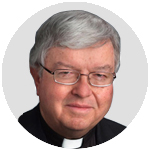
Father Kenneth Doyle
Q. I have heard that the “rite of betrothal” is becoming popular in certain young Catholic circles. What does this rite entail? Was it more common prior to the Second Vatican Council? Would you recommend that an engaged couple seek out this rite? (Washington)
A. The rite of betrothal was a little-known but long-standing service of prayer in which a couple had their engagement formally blessed by a priest. The 1906 edition of The Catholic Encyclopedia notes that the ritual was more common in other countries than in the United States. An English version is still available, as an addition to Father Philip Weller’s translation of the 1962 Roman Ritual (although the rite did not form part of that ritual itself.)
[hotblock]
There is no prohibition against using that rite today, although it has largely been replaced in the contemporary church by the Blessing of an Engaged Couple from the church’s Book of Blessings, published in 1989. That newer rite celebrates in prayer a newly engaged couple and asks the Lord to guide them as they prepare for marriage; it can be celebrated by a priest, deacon or lay minister (sometimes by a parent of the future bride or groom).
It includes scriptural readings — frequently from the 13th chapter of Paul’s First Letter to the Corinthians (“Love is patient, love is kind …”). The engagement rings may be blessed during the ceremony, and the celebrant prays:
“Lord God, the source of all love, the wise plan of your providence has brought these young people together. As they prepare themselves for the sacrament of marriage and pray for your grace, grant that, strengthened by your blessing, they may grow in respect for one another and cherish each other with a sincere love.”
I would recommend that a couple use this newer blessing.
Q. During the eucharistic prayer, our diocese prays by name both for our current bishop and also for our retired bishop. Yet I have never heard our pope emeritus (Pope Benedict) mentioned during the eucharistic prayer. Is there a reason why he cannot be mentioned along with Pope Francis? (Schenectady, New York)
A. It’s a good question, and I agree with the sentiment you express. Strictly speaking, neither a retired pope nor a retired bishop is to be mentioned at that part of the eucharistic prayer — the reason being that they no longer exercise pastoral authority.
[tower]
That question was answered in the March 2013 newsletter from the U.S. Conference of Catholic Bishops Committee on Divine Worship; that article explained that a retired pope or bishop, “while they retain their episcopal dignity and their standing within the order of bishops, they no longer symbolize, express or are responsible for the communion of the local or universal church.”
(The same article does permit mention of a retired pope or bishop in the prayer of the faithful or in the “commemoration of the living,” which is part of one of the four main versions of the eucharistic prayer.)
To be honest though, this all sounds rather technical to me, so here is what I have been doing. Four years ago, when our own bishop retired, the diocese announced that he could be mentioned by name along with his successor in the eucharistic prayer. It struck me that, by the same logic, we should be permitted to mention Pope Benedict, who had retired the year before.
So for the past four years — in whichever of the eucharistic prayers I am using — I have been praying publicly for our current pope and bishop and also for “Benedict, our pope emeritus, and Howard, our bishop emeritus.” No one has complained, and somehow I think that God doesn’t mind either.
***
Questions may be sent to Father Kenneth Doyle at askfatherdoyle@gmail.com and 30 Columbia Circle Dr., Albany, New York 12203.
PREVIOUS: Readings of the Holy Mass – Third Sunday in Ordinary Time
NEXT: Beyond a handshake: The profound nature of the sign of peace



Share this story